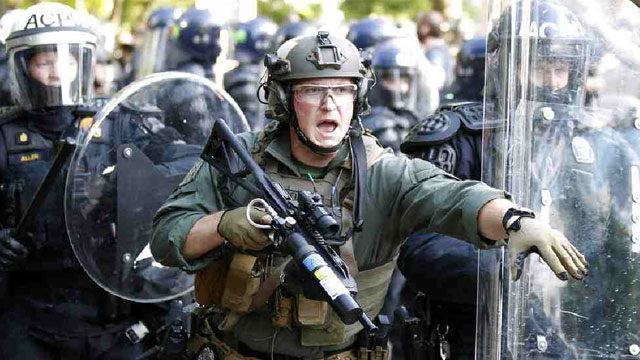US President Donald Trump on Monday threatened the governors that he would deploy the military to states if they did not stamp out violent protests over police that have roiled the nation over the past week.
If Trump truly sends troops against protesters, this will be an exercise of his federal authority.
Trump’s announcement came as police under federal command forced back peaceful demonstrators with tear gas so he could walk to a nearby church and pose with a Bible, reports AP.
Trump's bellicose rhetoric came as the nation braced for another round of violence at a time when the country is already buckling because of the coronavirus outbreak and the Depression-level unemployment it has caused.
The US President demanded an end to the heated protests in remarks from the White House Rose Garden and vowed to use more force to achieve that aim.
Trump said the U.S. military would step in to "quickly solve the problem for them," if state governors throughout the country do not deploy the National Guard in sufficient numbers to "dominate the streets,"
"We have the greatest country in the world," the president declared. "We're going to keep it safe."
Minutes before Trump began speaking, police and National Guard soldiers began aggressively forcing back hundreds of peaceful protesters who had gathered in Lafayette Park, across the street from the White House, where they were chanting against police brutality and the Minneapolis death of George Floyd. As Trump spoke, tear gas canisters could be heard exploding.
Floyd died last week after he was pinned to the pavement by a police officer who put his knee on the handcuffed black man's neck until he stopped breathing. His death set off protests that spread from Minneapolis across America. His brother Terrence pleaded with protesters on Monday to remain peaceful.
Five months before Election Day, the president made clear that he would stake his reelection efforts on convincing voters that his strong-arm approach was warranted to quell the most intense civil unrest since the 1960s.
He made little effort to address the grievances of black Americans and others outraged by Floyd's death and the scourge of police brutality, undermining what his campaign had hoped would be increased appeal to African American voters.
The scene in and around the White House on Monday night appeared to be carefully orchestrated. As the crowd of protesters grew, Attorney General William Barr arrived in Lafayette Park to look over at the demonstrations and the swarm of law enforcement.
The sudden shift in tactics against the protesters was initially a mystery. Then, after finishing his Rose Garden remarks, Trump emerged from the White House gates and walked through the park to St. John's Church, where an office had been set on fire the previous night.
Trump, who rarely attends church, held up a Bible and gathered a group of advisers — all white — to pose for photos.
The moment was quickly decried by Trump's critics, with New York Gov. Andrew Cuomo saying the president "used the military to push out a peaceful protest so he could have a photo op at a church."
"It's all just a reality TV show for this president," he said on Twitter. "Shameful."
The country has been beset by angry demonstrations for the past week in some of the most widespread racial unrest in the U.S. since the 1960s. Spurred largely by Floyd's death, protesters have taken to the streets to decry the killings of black people by police. Minneapolis Officer Derek Chauvin has been charged with murder, but protesters are demanding that three of his colleagues be prosecuted, too. All four were fired.
While most of the demonstrations have been peaceful, others have descended into violence, leaving neighborhoods in shambles, stores ransacked, windows broken and cars burned, despite curfews around the country and the deployment of thousands of National Guard members in at least 15 states.
On Monday, demonstrations erupted from Philadelphia, where hundreds of protesters spilled onto a highway in the heart of the city, to Atlanta, where police fired tear gas at demonstrators, to Nashville, where more than 60 National Guard soldiers put down their riot shields at the request of peaceful protesters who had gathered in front of Tennessee's state Capitol to honor Floyd.-AP





